

 The Accurate Reloading Forums
The Accurate Reloading Forums  THE ACCURATE RELOADING.COM FORUMS
THE ACCURATE RELOADING.COM FORUMS  Hunting
Hunting  African Big Game Hunting
African Big Game Hunting  The Spotted Challenge
The Spotted ChallengeGo  | New  | Find  | Notify  | Tools  | Reply  |  |
| One of Us |
The Spotted Challenge Kevin Thomas© My first acquaintance with this particular cat was back in July 2010. At the time I was guiding a client on a leopard and general plains game hunt on Zimbabwe’s vast Bubye Valley Conservancy. We’d used zebra quarters and a few impala as bait, spread across an area to the north, and to the west of Nengo Camp, and then eastwards onto the Bubye River, where we’d initially found the huge cat’s tracks on about the second day of the safari. Zebra is my preferred bait because the meat has a high yellow fat content and seems irresistible to leopard. It wasn’t long though, before he showed us just how wily he was – he’d hit bait once, and never return. We also hung a complete impala ram, unsecured with a bait chain, but with a small log tied to a hind leg as a drag, what my trackers call a ‘free bait’, the notion being that this wily old leopard would try and carry the bait to a place of his choosing, and then cache it. We’d then track the drag mark, find the half consumed bait and then site a blind. Unfortunately, it didn’t quite work out like that, because the cat found, and promptly cleaned up the bait in situ, leaving a tattered empty skin, with meat stripped bones hanging, and nothing else, and on that particular safari, we never got the big cat, however, I was determined that one day we would. In June of 2011, I was hunting out of the same camp with Jamie Cox from the UK. He and his son Josh were on a buffalo and general plains game safari, although at the time, we were also planning a July 2012 leopard and plains game hunt. I spoke to Jamie about the big cat and mentioned that it might be worth while once more booking Nengo Camp, and trying to succeed in getting what would undoubtedly be a magnificent trophy leopard. As if to rub it in, on our penultimate morning in camp, and at about 0600hrs we were sitting by the fire having an early morning coffee, when we heard either a young waterbuck or a wildebeest bleating in distress while being killed in the dense bush beyond the waterhole in front of the camp, and in the vicinity of where we’d hung the ‘free’ impala bait a few seasons prior. Given the amount of noise, I thought it was a lion doing the killing, but that evening we heard a monstrous leopard grunting down at the waterhole, just to the immediate right of my chalet. This went on for a while, before he moved off, grunting all the while, back towards where the morning’s kill had been made, and it was obviously the same big leopard that’d done the early morning killing. Clearly, after a hot day lying up, he’d come down to the water to slake his thirst before returning to his cached kill (over the years, I’ve noticed that this is a common trait with leopard in the evening, they’ll invariably go to water before beginning to feed). While we were still listening to him, I jokingly said to Jamie, “We have an appointment with that cat next year” – little did either of us realise how true those words would prove to be. Eventually, and following months of impatient waiting from all sides, and after numerous email exchanges between us counting the days to safari time, Jamie and Josh arrived in Bulawayo, on Friday 13 July 2012, and we went straight into Nengo Camp after a four hour drive from Bulawayo. Over the next few days we did the normal leopard hunting thing – spent our time looking for tracks and sign of a big cat. Our quest took us across most of the hunting block, and we concentrated on road/river crossings, checking in the sandy areas for spoor. Leopards seem to love walking along riverbeds and along roads. We also checked the surrounds of numerous waterholes and throughout the exercise we found ample sign of leopard movement, but always spoor of females or young males. On the third morning however, and whilst driving north along the west bank of the Bubye River, we struck gold – a huge cat had ambled down a narrow sandy bedded tributary to the Bubye, and about 100m from the Bubye River, he’d moved out of the tributary and then cut across through the riverine and down into the reedbeds on the main river. After having scouted around for a suitable bait tree, we soon found one in the tributary where his spoor had been coming and going, and it was a tree that would also afford us a decent blind site about 65 m away. Once this was done, we wasted no time in going out and looking for a suitable bait animal, and it didn’t take long before Josh shot a big zebra stallion, and soon after, we had four haunches hung as leopard bait, and two of them specifically sited to try and intercept what I was sure was the big cat because his familiar tracks found earlier in the day, had convinced my trackers we were playing with the same cat from previous seasons. During the course of hanging our bait, we’d ensured that there was plenty of zebra gut mix used to lay a scent trail, and we’d camouflaged the bait well from the keen eyes of vultures, by using ample evergreen gwarrie branches. We’d also hung the bait high to keep it out of reach of hyena, and the prying eyes of lion. Our second bait we hung in a tree about 6km north of the first bait, where we’d initially found the big cat’s tracks, and just below the Bubye River bank, about 100m from a well used waterhole in the riverbed – there were also ample thickets of reeds covering the riverbed and affording ideal cover for a leopard. More importantly, in the vicinity of the waterhole, we’d also found older leopard tracks in the river sand, and they appeared to belong to the same cat, thus our choice of a bait tree in that area. We also hunt two other baits, one south of where we’d found the big cat’s tracks, in case he’d moved off in that direction, and other midway between the furthest bait, and the bait where we’d found his spoor. This latter bait we placed in the same tree where Bill Haslett had shot his leopard two years before, this tree too, was situated in a tributary flowing into the Bubye River. After returning to camp in the late afternoon, we sat by the campfire enjoying a few cold beers and talking ‘leopard’, before having an enjoyable dinner and then hitting the sack. During the early hours on the next morning, probably at about 03hr00, I was awakened by a leopard grunting far off, and lying in my bed, I couldn’t ascertain the direction, so once more dozed off. After departing camp at first light on the morning of 17 July we did the normal obligatory bait checking drive, and found our main bait had been hit during the night, and by the same cat, who after feeding, had jumped out of the bait tree and disappeared into the dense reedbeds in the river. Not wasting time, we quickly drove away for about 2km inland of the river and cut our evergreen gwarrie to use as camouflage to hide the blind. My leopard blind is a collapsible square tube structure, which is easy, quiet, and quick to erect, once the frame is up we surround it with a wrap around length of 90% density shade cloth that is attached to the frame by plastic cable ties. We cut a shooting port for the client and a viewing port for me, in the shade cloth the first time I used it. Once the shade cloth has been secured in position, and the chairs placed inside the blind, we cover the entire outside of the blind with brush, normally gwarrie. After having completed this task, we moved away and then returned to camp where we checked the rifle for zero at the exact distance from blind to bait – 63m – and then had an early lunch, followed by a quick nap, and at 1545hrs we entered the blind, and had the trackers move a few kilometres away with my vehicle. Before they’d departed, and although we had handheld radios, I’d verbally instructed them that if they hadn’t heard a gunshot by 21hr30, they were to return and collect us. Obviously, and upon hearing a gunshot, they’d immediately drive straight back to the blind. There is little wrong with sitting all night, if one is of an inclination too, however, I’m firmly in that group of hunters who feel that if the leopard hasn’t fed by 21hr30, it is unlikely to come in. Perhaps you’ve compromised your presence in the blind, or maybe the leopard has made a kill of his own. The cat may also be an early morning feeder, in which case I still prefer to return to camp for a good night’s rest, and then quietly walk in during the pre-dawn darkness – quite often an exciting exercise in itself on a place like the BVC, because of elephant, buffalo, rhino or lion. I’ve always found sitting in a leopard blind quietly wiling the daylight hours away is almost therapeutic; there are all sorts of things going on beyond the flimsy blind walls. Crested francolin walk by, chirping to each other as they peck at insects, ants, and grass seeds, a covey of them walked across the front of the blind, between the shade cloth and the branches covering the blind, right in front of Jamie and my feet. At other times, I’ve watched starlings, and babblers, appearing on the ground immediately below the bait to feed on maggots, and tiny morsels of meat dropping from the bait. Mongoose too, and more particularly the slender-mongoose often stop by to snatch a bit of fallen meat, as do jackals, and of course ratels (badgers) are also regular visitors to the bait site – however, they’re unwelcome visitors because a pair of badgers in a noisy feeding frenzy, soon make short work of an impala haunch. Immediately outside of the blind, and even if they are coming from afar, one can listen to a variety of bush sounds, and if during the rut, impala rams are constantly chasing each other all over the place, snorting and blowing, while trying to dominate and lay claim to a female harem. Zebra too, are noisy and particularly so if frightened; wildebeest snort, and often one can hear a tree being pushed over by feeding elephant – if it happens close to the blind it soon gets your attention – and is frustrating if you can’t see the elephant. Black rhino moving to and from water can also be problematic, and that is why we avoid placing a leopard blind too close to water, or adjacent to a dangerous game trail. Normally, I only allow the client and myself in the blind, however, on this occasion Jamie wanted his 17-year old son Josh to share the experience, and the excitement, and I was quite happy for Josh to join us. The blind size dictated that Josh would have to sit in his camp chair immediately behind Jamie and me, and behind Josh but against his side; the two ends of the shade cloth were joined by a few cable ties, and formed the entrance to the blind. As the daylight began to fade, so too, did the bush sounds change from day sounds to night sounds, and early that evening, a lion pride began performing close to where we were sitting, and between us and my vehicle. It was clear to me that the pride had come out of the bush onto the narrow track that follows the Bubye River, so I just hoped they’d move downstream, and away from us, rather than towards us. Lion have absolutely no fear of man after sunset, and can be a real menace to those sitting in a ground blind made out of little else than thin woven plastic, and light brush. Normally, if lion do pose a threat to a ground blind, I opt to vacate the blind. On this occasion though, I was dearly hoping the cat would put in an early appearance, and Jamie’s killing shot chase off the lion. My optimism was short lived because once it was well and truly dark, the lion pride continued to grunt and roar, the ground vibrating with each vocal bout, luckily for us though, they seemed to be remaining in the same place, so we just continued to sit quietly. At 62 years old, my hearing is not what it used to be, and my left ear drum was blown out due to the muzzle blast from a client’s .300 Winchester Magnum back in about 1992 and so I really have to listen, when in a blind at night. While we were sitting there listening to the noisy lions, Jamie suddenly swung around and grabbing Josh, pulled him closer and said, “Watch out Josh!” and then, “Are you OK?” All I’d heard was what sounded like a faint tread behind the blind, and then it rapidly moved off, so thinking it was a hyena, I said nothing, and it was at about that time that Jamie had reacted so protectively towards his son. By 21hr30 nothing had happened and the lion were still performing, plus we’d heard some elephant breaking trees downstream of us, so it was a welcome sound to eventually hear my rig approaching from beyond where I’d guessed the lion were. When the trackers did eventually arrive, they excitedly announced they’d seen three lion, and were sure there were more in the brush. When exiting the blind, and right behind the opening, we found the reason for Jamie and Josh’s brief moment of concern. A black rhino had nearly walked into the flimsy back of the blind, its front feet tracks were about a metre behind the blind, and then the spoor swung away to the left – so much for my hyena! Once more, and after departing camp in the pre-dawn darkness, we did our bait checking run and found that after we’d vacated the blind, the lion pride had arrived and spent time beneath the bait tree, causing the leopard to stay away. Despite our sitting for another two nights, the leopard never came back. Our other baits were being hit by female leopard only, and one zebra haunch was stolen by poachers from the neighbouring tribal area. Because of our need for bait, Jamie had also shot a mature zebra stallion, and we hung two of its haunches, keeping the shoulders in reserve. Things then went quiet, until we again found the big leopard’s tracks in the Bubye River near a waterhole mid way between the bait he’d first hit and the one we’d hung near the waterhole to the north, judging from his tracks in the soft river sand, he appeared to be heading north, and this pleased us. A slight worry though was that the tracks we’d initially found had led away from the water and right past where I’d hoped to build a blind in the event of him feeding. Speaking to my trackers, we decided to cross that bridge when we came to it. Each morning though, when we checked the bait, we found it untouched although it was starting to putrefy nicely. In the interim, we continued to hunt and Josh shot a very good warthog and Jamie a bushpig. On 21 July this all changed. On our early morning drive by, the trackers excitedly remarked that it looked as if the bait had been hit – the previously cut branches hung as camouflage to keep vultures off the bait had been stripped off part of the bait, and were lying festooned on the ground under the tree – a good sign. Tracker Barnabas went down for a closer look, and then called us forward, the big cat had fed, and a fair amount, he’d also ripped a chunk of meat off the bait and it hung on a branch to one side. His tracks were in the sand at the base of the tree, and fortunately when he’d departed he’d gone south past the waterhole and straight into the dense reedbeds. We also found where he’d rested after feeding, guarding his ‘kill’ as such – his large body shape and tail sculpted into the river sand. We still had to be extra careful when choosing a blind site, and I was also concerned this particular leopard, true to his normal behaviour, wouldn’t return to the bait. Our other worry was lion activity of which there was plenty of sign, because if they turned up, the leopard definitely wouldn’t show. First however, we returned to the previous blind site, collapsed the blind and dropped the remains of the bait, and cut more fresh camouflage, then brought it all forward to the new site and erected the blind. We also adjusted the bait, to ensure it was positioned in a manner which would have the leopard feeding broadside on to us when Jamie took his shot. All of this was done as quietly as possible, although I couldn’t place the blind further than 43m away from the bait because of terrain, this was a bit close when hunting a wily old cat, and so it did worry me, but we had the added advantage of being on the riverbank well above the cat, although on the same level as the bait branch where we hoped he’d be standing. By 1545hrs we were in the blind and I’d again instructed the trackers to return with the vehicle at 2100hrs if they hadn’t heard a shot. Silence in a leopard blind is critical to the success of the exercise, and particularly so during the transitional period from day to night, because it is in that brief window that a leopard often appears, as if a fleeting, silent shadow from nowhere, however, Jamie and Josh sat unmoving, and once it was dark I hardly knew they were there. As the sun set, bird song quieted, and aside from a few impala snorting to the rear of the blind, there was no other noise. Suddenly at 1745hrs the leopard gave two throaty grunts Haugh Haugh in the reedbeds on the opposite side of the river, and downstream of us – then all went quiet. At 1820hrs we heard his saw like grunt closer to us, right at the waterhole and about 100m from the bait tree, again a deep throated Haugh Haugh and then silence. It was pitch dark and we couldn’t see a thing in or outside of the blind, so just sat quietly with our ears straining to pick up any sound in the vicinity of the bait tree. By 2000hrs I was starting to think the leopard had moved off and wouldn’t come in to the bait. Leaning forward in my chair, as is my want when listening inside a blind, I was reflecting on how many days we had left and what else I could try, in order to get a leopard for Jamie – my mindset having virtually accepted, that this wily cat had once more outwitted us. Just then, I heard the faint but distinct crackle of dry leaf matter being walked on – the sound had come from the base of the bait tree. Tapping Jamie on the knee, I leant even further forward, and glancing at my watch saw that it was 2012hrs. Suddenly we heard it again, more distinct – leaves and dry twigs being disturbed, and then at 2014hrs the cat scrambled noisily up the tree – determined, and confident. He then immediately began to strip the camouflage off the bait, striking the branches and sending them spiralling earthwards. Then he bit into the zebra rib cage, a loud bone crunching sound that carried through the darkness and into the blind. With the noise of the leopard feeding, I leant towards Jamie and whispered, ‘That’s definitely the big cat, when I light him up shoot him’ and then I quietly stood up, pointed the red lens spotlight skywards, switched it on, and then brought the beam down in a slow arc onto the bait. The leopard was exactly where he should have been, standing on the branch broadside on. He paid no heed to the red beam and was staring down at the bait he’d so recently been tearing apart, so Jamie placed a .375 H&H 300grn PMP soft point bullet into the centre of the cat’s shoulder. In tandem with the shot, the leopard did a backward flip and disappeared from sight. We heard it crash off into the reedbeds without any vocal noises, and then just as suddenly all went quiet – an eerie sort of quiet. Talking afterwards while we waited for the vehicle, Jamie felt it was the best shot he’d ever made, and because of the seemingly blind crashing rush through the reeds, followed by immediate silence, I was convinced the leopard was dead. When the trackers arrived, we moved down to the bait tree and found a few tiny specks of blood and then two trackers and I, using the spotlight, followed the blood trail into the reed thicket, my 12ga 3” magnum hard in my shoulder. Those were a tense few minutes, however, we soon found the leopard lying dead – a magnificent cat, whose skull measurements using the SCI system were verified as scoring 17 10/16” and then later, towards the year’s end I was notified by the ZPHGA (Zimbabwe Professional Hunters & Guides Association) that the leopard was the biggest taken by one of their members in Zimbabwe during the 2012 season. The .375 H&H 300gr soft-point had entered the body on the point of the shoulder and then diverted and passed through the lungs, destroying them totally, before exiting the rib cage and forcing a bit of lung out of the bullet exit hole. Kevin Thomas Safaris Zimbabwe - Eastern Cape E-mail: ktsenquiries@mweb.co.za Website: www.ktsafaris.co.za | ||
|
| One of Us |
Great story. Thanks for posting. Picture? | |||
|
| One of Us |
Great story - thanks for the details. Please post a few photos if you have them. | |||
|
| One of Us |
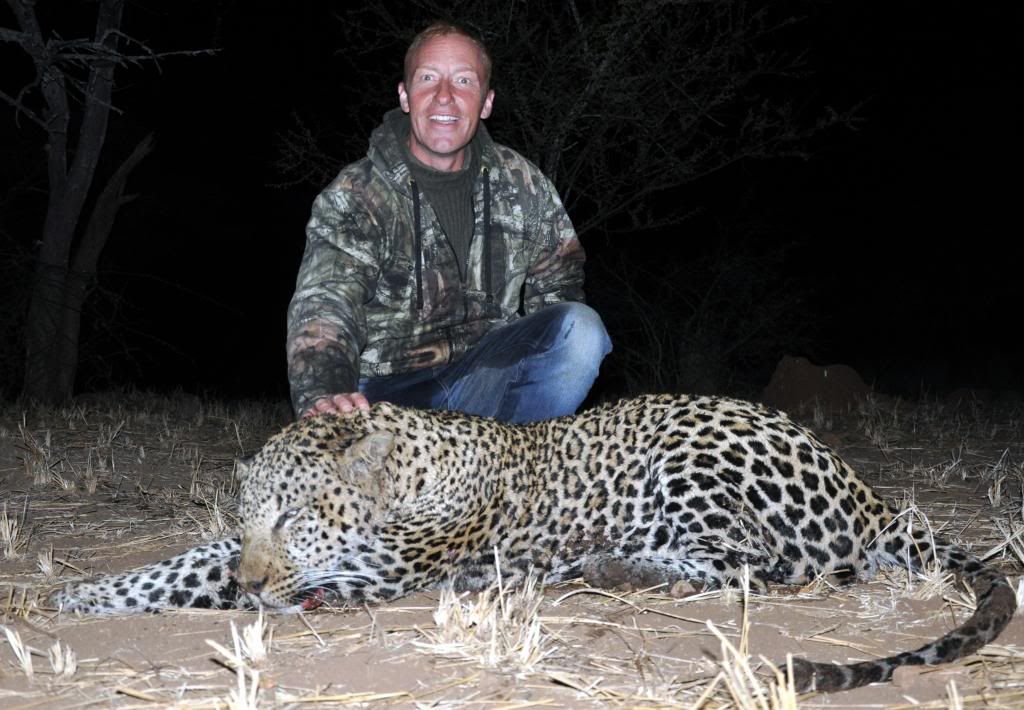 Kevin Thomas Safaris Zimbabwe - Eastern Cape E-mail: ktsenquiries@mweb.co.za Website: www.ktsafaris.co.za | |||
|
| One of Us |
 Once again we hunted out of Nengo Camp. 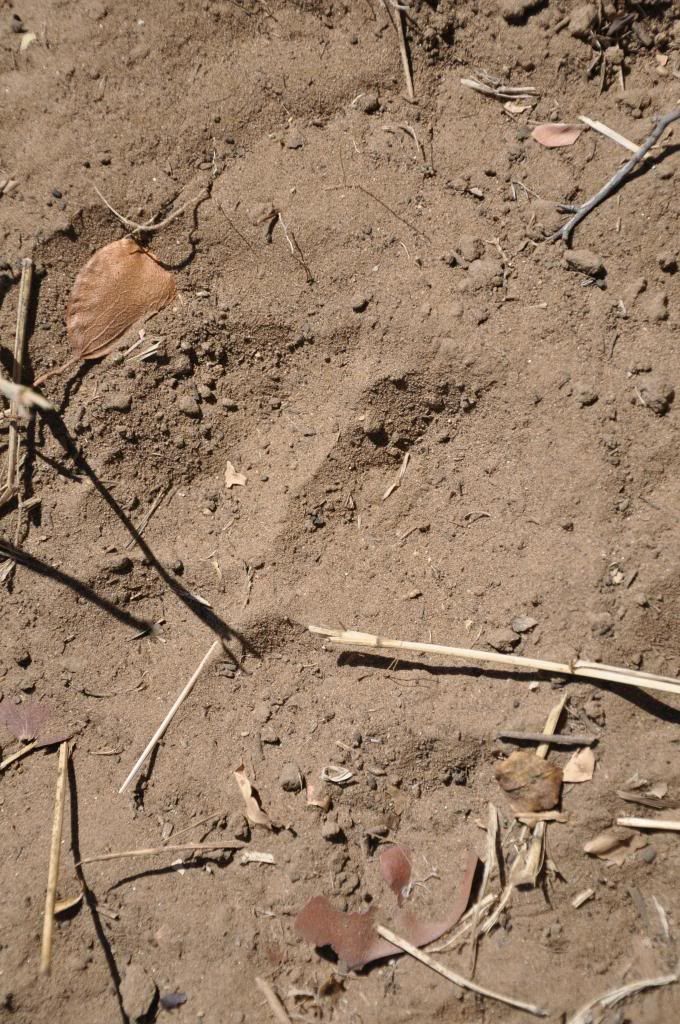 The distinctively large pugmark of the leopard. 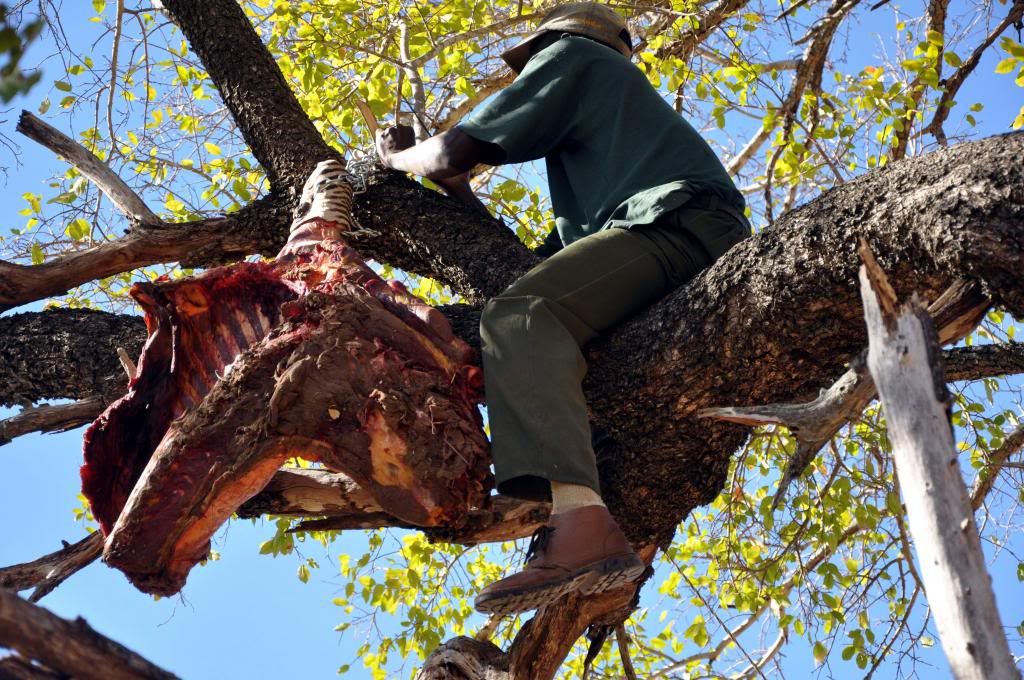 Tracker Barnabas securing a zebra haunch bait.  Looking at the camouflaged bait from the blind – the bait has been highlighted in red. The leopard would be standing on the angled branch to the right of the bait. 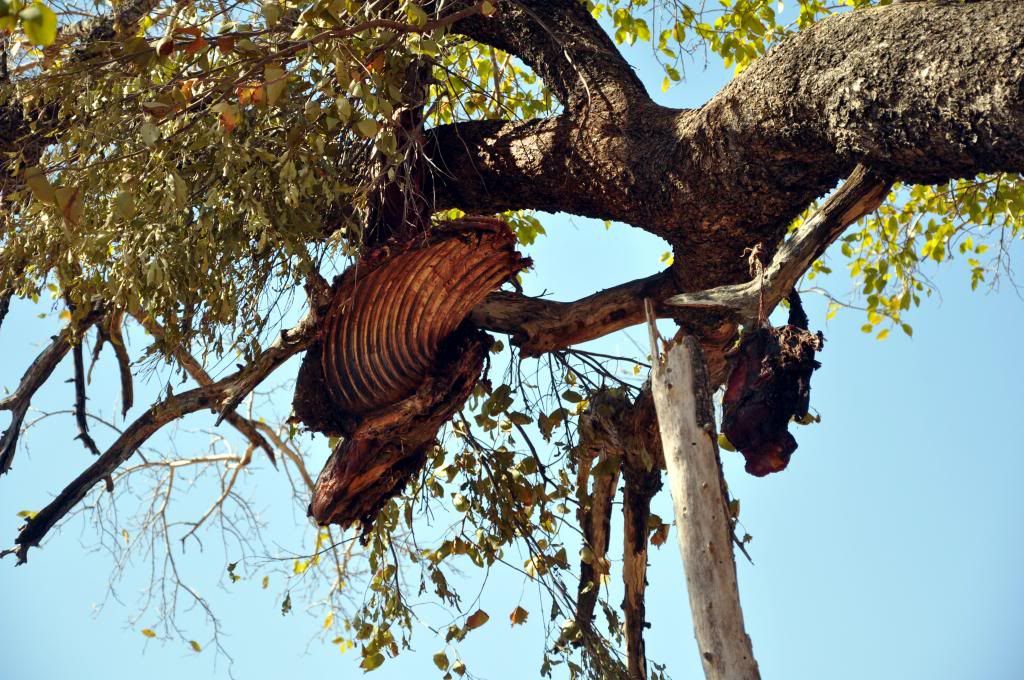 … he’d also ripped a chunk of meat off the bait and it hung on a branch to one side. 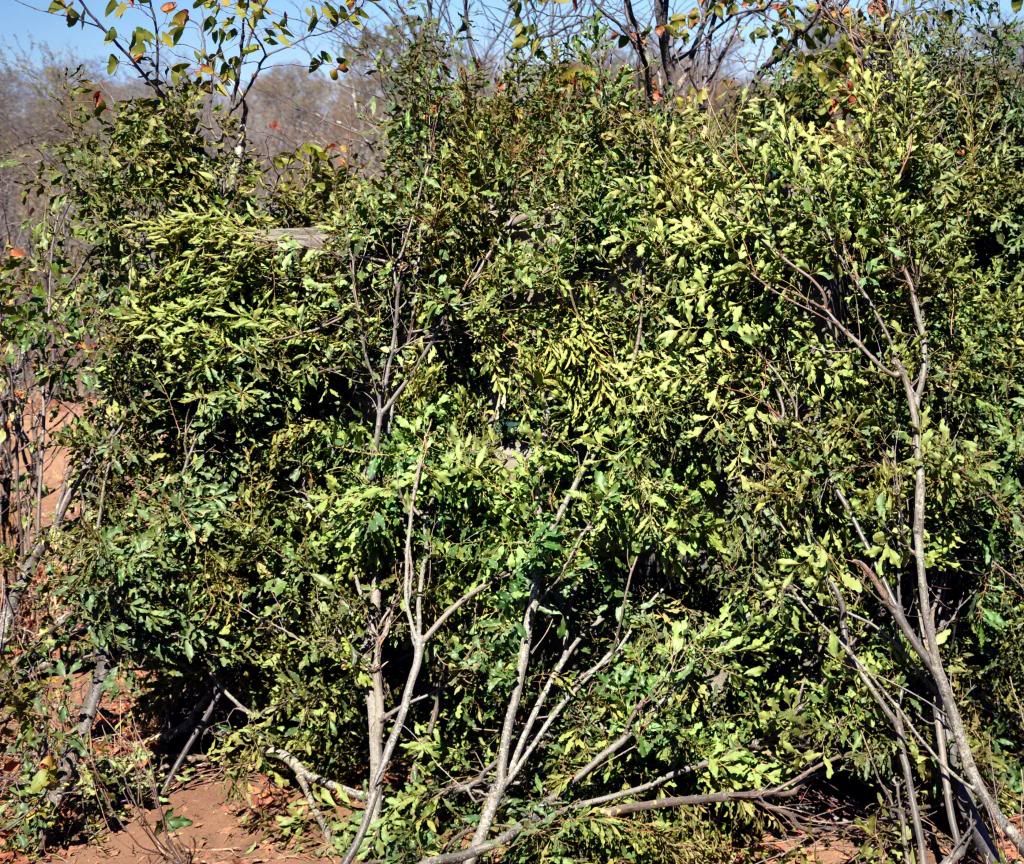 The blind upon completion. Kevin Thomas Safaris Zimbabwe - Eastern Cape E-mail: ktsenquiries@mweb.co.za Website: www.ktsafaris.co.za | |||
|
| One of Us |
Beautiful cat - looks like a twin to the one I shot on Debshan Ranch on 7 April. | |||
|
| One of Us |
Congrats on a beautiful leopard! Dave Fulson | |||
|
One of Us |
Great story! And an even better leopard Manuel Maldonado MM Sonoran Desert Hunters | |||
|
| One of Us |
Thanks for a very well written and fascinating story. What a gorgeous and big tom leopard. Well done! | |||
|
| one of us |
Great article ,Kevin ,excellent as your books and Magnum magazine articles .Next tripto SA ill visit you ,thanks for signing my book . Juan Pablo Pozzi Zurbriggen md. www.huntinginargentina.com.ar FULL PROFESSIONAL MEMBER OF IPHA INTERNATIONAL PROFESSIONAL HUNTERS ASOCIATION . DSC PROFESSIONAL MEMBER DRSS--SCI NRA IDPA IPSC-FAT -argentine shooting federation cred number2- | |||
|
| Powered by Social Strata |
| Please Wait. Your request is being processed... |
|

Visit our on-line store for AR Memorabilia

